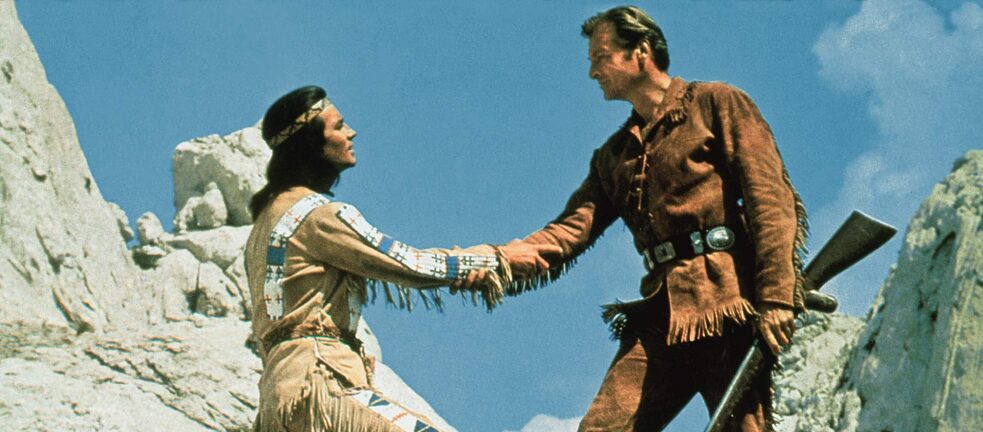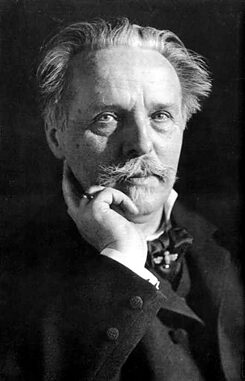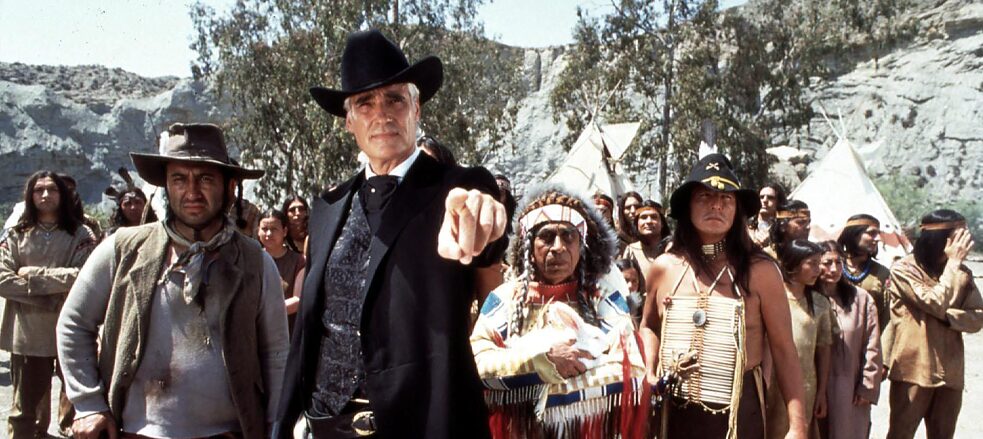The Fascination of the Wild West
I Left My Heart on the Prairie

On the other side of the Atlantic, people widen their eyes in amazement at the Germans' love of American cowboys, and what is likely the greatest number of hobby cowboys outside the USA. A brief look at what is probably Germany's oldest live role-playing game.
By Matthias Bischoff
Walking into the Hammer Ranch in Frankfurt-Seckbach is like immersing yourself in a strange, bygone era. Even the buildings seem to come from another time. There are log cabins everywhere, here with a sign reading “Blacksmith”, there with “Saloon”. In between, fires burn, steaks the size of bathmats sizzle, plenty of beer flows, and musicians play the banjo, fiddle and piano.
Wild West with German thoroughness
There are quite a few places in Germany visitors can take this kind of leap back in time, with hundreds of groups working hard to preserve traditions. Not German traditions though. These are the customs of the American West from the mid to late 19th century. Founded in 1966, the Frankfurt Western Club, for example, was inspired by a family that had emigrated to Arizona. The Hammer Ranch owned by distant relatives in the Wild West served as a model for the replica set among allotments and industrial estates.
In the forests of the Bergisches Land, not far from Cologne, German enthusiasts of Native Americans regularly camp on a riverbank. Fake Iroquois and Crow cavort around pointed tipis. In the vast expanse of North America, these tribes would never have met. Here near Bergisch-Gladbach, they live side by side. The “Trappers Kaltenbroich” association established the camps. A look at the website shows how important the culture of indigenous peoples is to members of the association, as it is for other organisers. Clothing, drums and weapons are manufactured as authentically as possible, and participants learn about the traditions in depth. The “Wild West” has been a popular hobby in Germany for many decades, where it is cultivated with the legendary German thoroughness. The “Western Bund” website lists about a hundred clubs throughout the country, but there are many more.
How!
 He spun a tale for all he was worth and created two of the most iconographic figures of the 20th century in Winnetou and Old Shatterhand: Karl May.
| Photo (detail): © gemeinfrei
But where does it come from, this German love of the Wild West, of cowboys, trappers, settlers, and Native Americans? Part of the answer is easy: Winnetou. It would be hard to find someone born in Germany between 1880 and 1980 who has never heard the name at some point. For a century, the gloriously noble Apache chief, invented by brilliant fibber Karl May, was an iconographic figure equal in rank to Harry Potter or Darth Vader. Karl May’s completely fabricated novels written in the first person, which he initially cheekily sold as authentic travelogues, made him a rich man even before his death in 1912 and sold more than 200 million copies worldwide over the course of the 20th century (as of 2015). In the 1960s, the three Winnetou books, The Prince of Oil, The Treasure in Silver Lake and many others were filmed with a huge budget for the time. The silver screen and later television ensured that there was no escape from the adventures of German surveyor “Charly”, who in his alter ego as the almost invincible “Old Shatterhand” befriends the Apaches and incidentally has German nobility and Christianity tucked up his sleeve. Sayings from the books have become proverbial, such as sending someone “to the eternal hunting grounds” or killing them. Then there is “How! I have spoken,” with which Karl May ends every monologue given by a Native American chief. Unfamiliar with English pronunciation, the Germans said it as “Hook!”, which you can still hear on occasion today.
He spun a tale for all he was worth and created two of the most iconographic figures of the 20th century in Winnetou and Old Shatterhand: Karl May.
| Photo (detail): © gemeinfrei
But where does it come from, this German love of the Wild West, of cowboys, trappers, settlers, and Native Americans? Part of the answer is easy: Winnetou. It would be hard to find someone born in Germany between 1880 and 1980 who has never heard the name at some point. For a century, the gloriously noble Apache chief, invented by brilliant fibber Karl May, was an iconographic figure equal in rank to Harry Potter or Darth Vader. Karl May’s completely fabricated novels written in the first person, which he initially cheekily sold as authentic travelogues, made him a rich man even before his death in 1912 and sold more than 200 million copies worldwide over the course of the 20th century (as of 2015). In the 1960s, the three Winnetou books, The Prince of Oil, The Treasure in Silver Lake and many others were filmed with a huge budget for the time. The silver screen and later television ensured that there was no escape from the adventures of German surveyor “Charly”, who in his alter ego as the almost invincible “Old Shatterhand” befriends the Apaches and incidentally has German nobility and Christianity tucked up his sleeve. Sayings from the books have become proverbial, such as sending someone “to the eternal hunting grounds” or killing them. Then there is “How! I have spoken,” with which Karl May ends every monologue given by a Native American chief. Unfamiliar with English pronunciation, the Germans said it as “Hook!”, which you can still hear on occasion today.
Karl May is not the only reason, not by a long chalk. The novels of J.F. Cooper, The Leatherstocking Tales and The Last of the Mohicans, were also immensely popular in the 19th century. Around 1800, Goethe raved “America, you have got it good!” alluding to the longing for a free, unencumbered life prevalent in constrained Germany, which was dominated by small princely states. Until the First World War, there were repeated waves of emigration. Along with the Irish and Italians, Germans were one of the largest immigrant groups, and so countless Germans had some kind of family connection to the USA. The love of “cowboys and Native Americans” has become a tradition in Germany. Children and even adults select their Carnival fancy dress accordingly, and very few seem aware that this might be a form of cultural appropriation.
The myth lives on
Thousands of visitors also flock to the Karl May festivals in Sauerland in Westphalia or in Saxony every year. The most famous open-air festival has been held in Bad Segeberg near Lübeck since the early 1950s. Under the “A town plays Karl May” motto, many residents of Bad Segeberg have taken part as extras. While first production had to make do with 25,000 German marks, today the budget stretches to many millions of euros. And although Pierre Brice, the most popular film and stage Winnetou of all time, has been in the eternal hunting grounds for several years now, almost 400,000 visitors come to Bad Segeberg every year. The myth lives on.
This is reflected in a look at the silver screen: Almost all Karl May adaptations from the 1960s are among the 20 most successful German films since 1945. But with 11 million viewers in cinemas alone, Bully Herbig’s Karl May parody Der Schuh des Manitu (The Shoe of Manitu) has been the undisputed number one since 2001. Parodies can only work if lots and lots of people, ideally an entire society, are familiar with the earnest original. The film mocks all clichés of the Wild West à la Karl May. Its phenomenal success proved once again that you cannot go wrong in Germany if you combine Karl May with comedy. Perhaps because quite a few Germans have left their hearts on the prairie.
 Decades after Winnetou, in 2001 Bully Herbig made fun of everything the Wild West genre had to offer with “Der Schuh des Manitu” – including Sky Dumont as the villain Santa Maria, whose song-and-tap-dance routine in the style of an advertising jingle about the “Superperforator” was a film highlight.
| Photo (detail): © picture alliance/United Archives
Decades after Winnetou, in 2001 Bully Herbig made fun of everything the Wild West genre had to offer with “Der Schuh des Manitu” – including Sky Dumont as the villain Santa Maria, whose song-and-tap-dance routine in the style of an advertising jingle about the “Superperforator” was a film highlight.
| Photo (detail): © picture alliance/United Archives